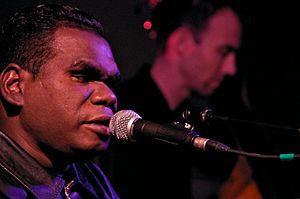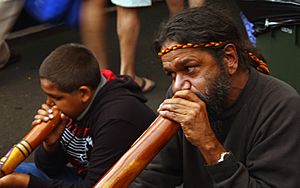Indigenous music of Australia facts for kids
Indigenous music in Australia is the vibrant music of the Aboriginal and Torres Strait Islander peoples. It has been a central part of their cultures and ceremonies for thousands of years. This music includes many unique ways of performing and special instruments found only in certain regions. Some musical traditions are also shared across much of Australia. The music of the Torres Strait Islanders is similar to music from nearby New Guinea. Music is super important for keeping Indigenous Australian cultures alive.
Since Europeans arrived in Australia, Indigenous musicians have also learned and performed many Western music styles. They often mix these with their traditional instruments and feelings. Likewise, non-Indigenous artists have used Indigenous Australian styles and instruments in their own work. Today, you can hear many talented Indigenous Australian performers in styles like rock and roll, country, rap, hip hop, and reggae.
Contents
Amazing Traditional Instruments
Indigenous Australians have created many unique musical instruments. These instruments are often used in ceremonies, storytelling, and celebrations.
The Didgeridoo
The didgeridoo is a very old wind instrument. It is a long tube, usually made from a hollowed-out eucalyptus tree branch. Players blow into it to make a continuous, deep humming sound. Skilled players use a special breathing technique called circular breathing to keep the sound going without stopping. Traditionally, only men in northern Australia played the didgeridoo. Today, it is widely known as a symbol of Aboriginal Australia around the world. However, it's important to remember that some Northern Aboriginal people feel it should only be played by initiated Indigenous men.
Clapsticks
Clapsticks are percussion instruments. They are usually two sticks that are hit together to create a rhythmic sound. Unlike drumsticks, which hit a drum, clapsticks are designed to strike each other. They are sometimes decorated with paintings of animals like snakes or lizards. They are also known as 'tatty' sticks.
Gum Leaf Music

The leaf of a gum tree can be used to make music! People hold the leaf and blow across it, like a small whistle. This instrument was originally used to call birds. You might have heard a similar "Coo-ee" call in old TV shows like Skippy the Bush Kangaroo.
The Bullroarer
A bullroarer is an instrument used in special ceremonies. It has a flat piece of wood attached to a cord. When a player swings the wood around in circles, it makes a humming sound. Changing how fast it spins changes the sound's intensity.
The Rasp
A rasp is a percussion instrument similar to a Güiro. It's a serrated stick or club. The edge of a boomerang is sometimes scraped along it to make a trilling sound.
Traditional Songs and Stories
Indigenous Australian music is deeply connected to ancient stories, history, and the land itself.
Clan Songs (Manikay)
Manikay are special "clan songs" from the Yolngu people in north-east Arnhem Land. These songs often tell stories about family history, important events, social connections, and love. They can even be updated to include references to popular films and music! Manikay are a sacred tradition, helping the Yolngu understand their world and connect with their ancestors. They are often performed during public ceremonies.
Songlines: Musical Maps
Songlines, also called "dreaming tracks," are like ancient maps across the land or sky. They mark the paths that creator beings followed during The Dreaming, which is a very important time in Indigenous beliefs. These paths are remembered through song cycles, stories, dances, and art. Songlines help people navigate and understand their country.
Early Recordings of Music
Some of the first records of traditional Aboriginal music were made by visitors and settlers. In 1793, Edward Jones (Bardd y Brenin) wrote down an Aboriginal song in London. Two Eora men from the Sydney area, Yemmerrawanne and Bennelong, sang a song in the Dharug language while visiting England.
Music from Northern Australia
Bunggul: Song, Music, and Dance
The Yolngu people use the term Bunggul to describe a ceremony that includes song, music, and dance. These ceremonies are performed in central to eastern Arnhem Land. Bunggul songs have specific words and a special structure. They often tell epic stories of ancestors from the Dreamtime. The lyrics can change and be improvised by the musicians and lead singer. The leader of the ceremony guides both the dancers and the music. The Garma Festival often features nightly Bunggul performances, which are seen as incredibly valuable to Australian culture. In 2023, a special Bunggul honored the late Yolngu leader Galarrwuy Yunupingu.
Kun-borrk Songs
Kun-borrk songs come from areas east of the Adelaide River and across to the Mann River. These songs always include actual words, unlike some other styles that might use sounds. They often have short breaks. Kun-borrk songs usually start with the didgeridoo, then the clapsticks, and finally the singing. A famous master of Kun-borrk was David Blanasi.
Wajarra: Fun Songs
Wajarra are non-sacred songs that started in the Gurindji region. They are performed just for fun and entertainment. During the 20th century, these songs traveled far across northern and western Australia. They spread along the stock routes as Aboriginal workers and their families moved between cattle stations.
Wangga: Ceremonial Music
Wangga music originated near the Alligator Rivers. These songs start with a very high note, along with rhythmic percussion, then suddenly shift to a low tone. Wangga is usually performed by one or two singers with clapsticks and a didgeridoo player. These songs are often part of special ceremonies, such as those to purify a deceased person's belongings with smoke.
Modern Indigenous Music Stars
Many Indigenous Australians have become famous musicians, blending traditional sounds with modern styles.

Indigenous musicians have achieved great success in many genres. Artists like Jimmy Little (pop), Yothu Yindi (rock), Troy Cassar-Daley (country), and Jessica Mauboy (pop, R&B) are well-known. Their music often gains attention through events like the WOMADelaide festivals. Geoffrey Gurrumul Yunupingu, a former member of Yothu Yindi, became internationally famous singing in English and in one of the Yolngu Matha languages.
Talented Torres Strait Islander musicians include Christine Anu (pop) and Seaman Dan.
Contemporary Indigenous music continues old traditions while also mixing with modern styles like rock and country music. Awards like The Deadlys celebrate these diverse musical styles. Traditional instruments like the didjeridu and clapsticks are often used, giving the music a unique sound.
Country music has been very popular among Aboriginal and Torres Strait Islander peoples for many years. Pioneers like Tom Foster, Dougie Young, and Jimmy Little paved the way. Today, Troy Cassar-Daley is a successful Indigenous country music performer. Artists like Kev Carmody and Archie Roach combine folk-rock and country to sing about important issues for Aboriginal people. The documentary and book Buried Country highlights many significant Indigenous musicians from the 1940s to the 1990s.
The movie Wrong Side of the Road (1981) and its music helped bring attention to Indigenous experiences in cities. It featured bands like Us Mob and No Fixed Address.
Australian hip hop music and rap music also have many Aboriginal artists. Baker Boy, who was named Young Australian of the Year in 2019, raps and sings in Yolngu Matha.
The unique artist Mojo Juju has won several awards since 2018. Her music has been featured in TV shows like Underbelly: Razor.
Thelma Plum released her first album, Better in Blak, in July 2019.
DOBBY is an Aboriginal and Filipino musician, known as a rapper and drummer. He sings in the Murrawarri language and English, and is an activist for Aboriginal issues.
The band King Stingray was started by the nephew and son of founding members of Yothu Yindi. They call their sound "Yolngu surf rock". Their first song came out in October 2020.
In 2024, blues musician Kankawa Nagarra (Olive Knight), at 80 years old, won the prestigious Australian Music Prize for her debut album, Wirlmarni.
Learning Music: Training Institutions
The Centre for Aboriginal Studies in Music (CASM) was founded in 1972. It is now part of the National Centre for Aboriginal Language and Music Studies at the University of Adelaide. CASM offers courses to help young Indigenous musicians develop their skills. It has a modern recording studio, teaching rooms, and practice spaces. Many successful musicians and bands, such as Coloured Stone and Electric Fields' Zaachariaha Fielding, have studied at CASM.
Explore More
- 3KND community radio station
- Aboriginal rock music
- Buried Country, film and book about Indigenous country music
- Central Australian Aboriginal Media Association (CAAMA), an organization that supports Aboriginal music
- National Indigenous Music Awards
- Deadly Awards
- First Nations Media Australia, a national group for Indigenous broadcasting and media
- Indigenous Australian hip hop
- Stompen Ground, a festival in Broome
- Vibe Australia
- Skinnyfish Music



